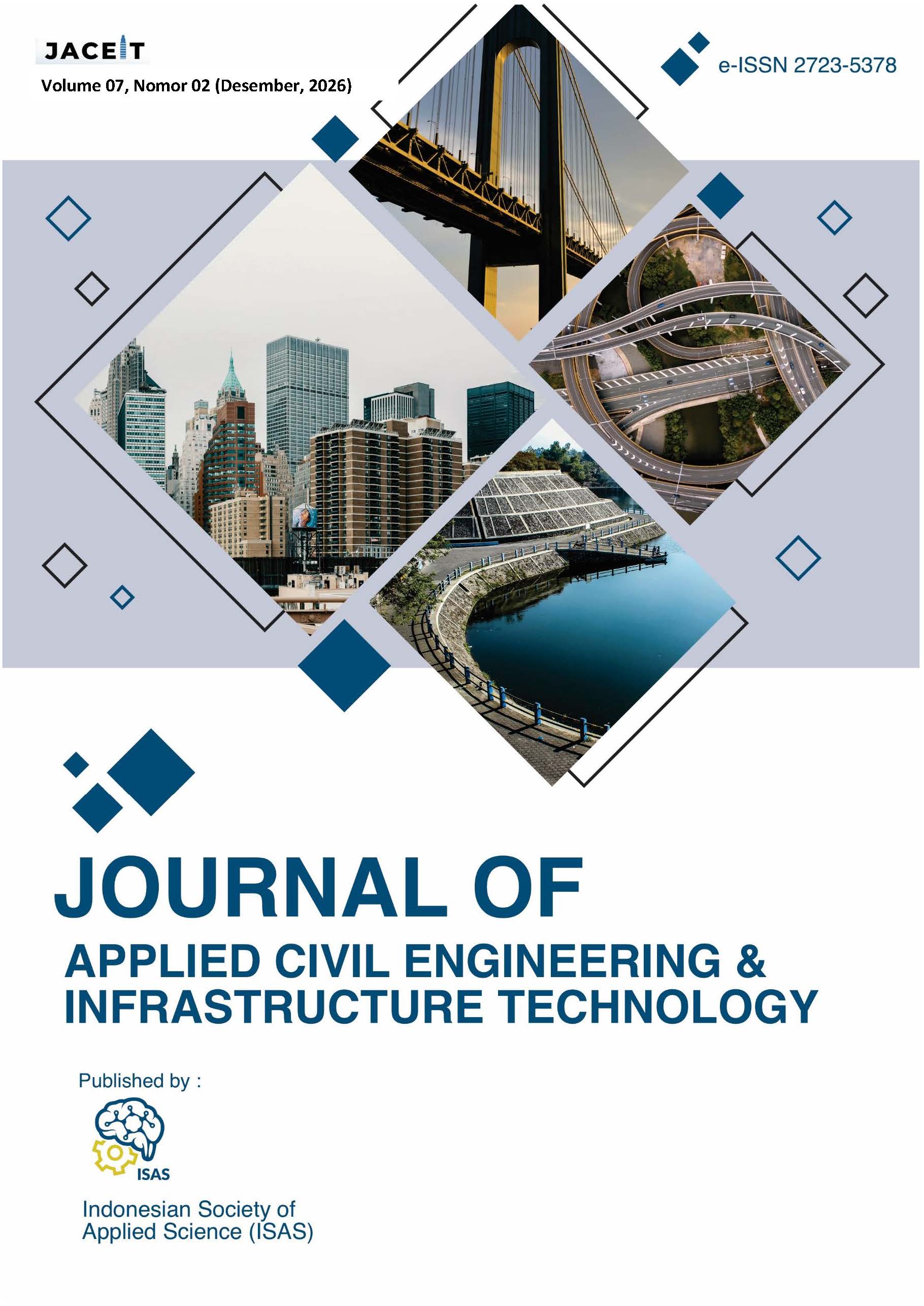Simulasi Angka Keamanan Menggunakan Metode Elemen Hingga Berdasarkan Nilai Kohesi (c) dan Sudut Geser Dalam
DOI:
https://doi.org/10.52158/jaceit.v7i2.962Keywords:
Safety Factor, Cohesion, Internal Angle of Friction, Expansive Soil, Triaxial UUAbstract
Expansive soil is a type of soil that can expand and shrink based on the moisture content. In Cisauk Subdistrict, Tangerang City, there are many damages to building structures and/ or roads caused by the expansive soil. This research is intended to identify the expansive soil, including its physical characteristics, in determining the cohesion (c) and internal shear angle (f) values using the UU (unconsolidated undrained) triaxial test. Test results indicated that the cohesion value was around 0.33 kg/cm² or 32.94 kN/m², and an internal shear angle of 20.51°. Both datasets were used to analyze slope stability modeling in defining the safety factor (SF) using PLAXIS software in 2D during rainy and dry seasons. Each condition was evaluated by the three slope variations, such as 20°, 40°, and 60°. Modeling results show that the (SF) would be higher on flatter slopes, and on the contrary, would decrease on steeper slopes. In addition, the (SF) would be higher during the dry season than the rainy season. The soil condition would be more saturated during the rainy season.
References
H. C. Hardiyatmo, Mekanika tanah I, 3rd ed. Yogyakarta: Gadjah Mada University Press, 2002.
United States Geological Survey (USGS), “What is Soil?”
T. H. Al-Yaqoub, J. Parol, and D. Znidarcic, “Experimental investigation of volume change behavior of swelling soil,” Appl Clay Sci, vol. 137, pp. 22–29, Mar. 2017, doi: 10.1016/J.CLAY.2016.11.018.
T. Daniel, Indarto, and S. R.A.A., “The Effects of Water Content Variation on Adhesion Factor of Pile Foundation in Expansive Soil,” Civil Engineering Dimension, vol. 15, no. 2, Sep. 2013, doi: 10.9744/ced.15.2.114-119.
“American Association of State Highway and Transportation Officials (AASHTO),” 1981
American Society of Civil Engineers (ASCE), “Soil Mechanics Overview.”
L. D. Jones and I. Jefferson, “Expansive soils. ICE Manual of Geotechnical Engineering: Second Edition, 1, 447–477,” pp. 447–477, 2012.
K. Terzaghi, Theoretical Soil Mechanics. John Wiley & Sons. 1943.
J. E. Bowles, Foundation analysis and design. McGraw-Hill, 1996.
B. M. Das, Principles of Geotechnical Engineering. 2010.
ASTM International, “ASTM D4318-17: Standard test methods for liquid limit, plastic limit, and plasticity index of soils,” West Conshohocken, 2017.
ASTM International, “Standard Test Method for Particle-Size Distribution (Gradation) of Fine-Grained Soils Using the Sedimentation (Hidrometer) Analysis, ASTM D7928-21,” West Conshohocken, 2021.
ASTM International, “D2487 - 17: Standard Practice for Classification of Soils for Engineering Purposes (Unified Soil Classification System),” 2017 doi: 10.1520/D2487-17.
American Association of State Highway and Transportation Officials, “Standard specification for classification of soils and soil-aggregate mixtures for highway construction purposes,” 1991
Skempton, “International Society for Soil Mechanics and Geotechnical Eenginering. The Colloidal ‘Activity’ of Clays L’Activité colloïdale des argiles,” 1953, [Online]. Available: https://www.issmge.org/publications/online-library
H. B. Seed, R. J. Woodward, and R. Lundgren, “Prediction of Swelling Potential for Compacted Clays. Journal of Soil Mechanics and Foundation Engineering Division, 88, 53-87,” 1962.
ASTM International, “Standard Test Methods for Laboratory Compaction Characteristics of Soil Using Standard Effort, ASTM D698-21,” West Conshohocken, 2021.
ASTM International, “Standard Test Method for Unconsolidated-Undrained Triaxial Compression Test on Cohesive Soils, ASTM D2850-21,” West Conshohocken, 2021.



